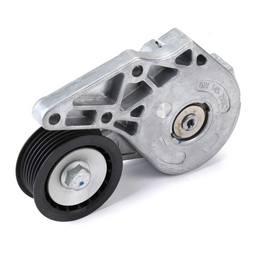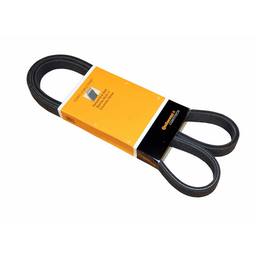Welcome to another part of our VW VR6 engine series, where we go over the most common issues associated with this engine. This time around we’re looking into the VR6 serpentine belt tensioner issue. We’ll explore the vital role of the serpentine belt tensioner within the engine, understanding its significance in keeping the various components running smoothly. As we move along, we’ll uncover the common issues that VW VR6 owners encounter with their tensioners, understanding the underlying causes and potential consequences of these problems.
Maintaining a well-functioning serpentine belt tensioner is crucial for optimal engine performance, and it’s essential for VW VR6 owners to be aware of the telltale signs of serpentine belt tensioner troubles. We’ll highlight the key symptoms that indicate a faulty tensioner, allowing you to take early action and prevent further damage to your engine.

Understanding the Serpentine Belt Tensioner
The serpentine belt tensioner is an essential component in the engine system of the VW VR6 Series. It plays a crucial role in ensuring the smooth and efficient operation of the vehicle. The primary function of the tensioner is to maintain the proper tension of the serpentine belt, which drives various engine accessories such as the alternator, power steering pump, water pump, and air conditioning compressor.
How the Serpentine Belt Tensioner Works
To understand the importance of the tensioner, let’s take a closer look at how it operates. The serpentine belt, aptly named for its snake-like path around various engine components, is a single, continuous belt that wraps around several pulleys. These pulleys are connected to different engine accessories, and as the engine runs, the serpentine belt transfers power from the crankshaft to these accessories, enabling them to perform their respective functions.
The tensioner is a spring-loaded pulley that exerts pressure on the serpentine belt, keeping it taut. This tension is essential to prevent slippage and ensure that the belt remains in constant contact with all the pulleys, transmitting power efficiently. As the engine runs, the tensioner adjusts automatically to accommodate changes in belt length due to wear and temperature variations.
VW VR6 Series vehicles typically use either an automatic serpentine belt tensioner. Automatic tensioners are more common in modern vehicles and rely on a spring-loaded mechanism to maintain the correct tension automatically.
Importance of Serpentine Belt Tensioner Maintenance
Given its critical role in the engine’s operation, maintaining the serpentine belt tensioner is of utmost importance. A properly tensioned belt ensures that all engine accessories function optimally, contributing to better performance, fuel efficiency, and overall reliability. Neglecting tensioner maintenance can lead to various issues, including premature belt wear, reduced accessory performance, and, in severe cases, engine damage.
Common VW VR6 Serpentine Belt Tensioner Issues
Despite its importance, the serpentine belt tensioner is not immune to problems, and VW VR6 Series owners may encounter various issues with this critical component. Understanding these common problems can help you identify potential tensioner issues and take prompt action to avoid more extensive damage. Let’s explore the most frequently faced serpentine belt tensioner issues:
Tensioner Pulley Wear
Over time, the pulley in the tensioner can experience wear and tear due to the constant stress of maintaining belt tension. As the pulley bearings wear out, you may notice unusual noises coming from the engine bay, such as squealing or chirping. Additionally, a worn tensioner pulley may cause the serpentine belt to slip, leading to reduced performance of engine accessories like the alternator and power steering pump.
Tensioner Spring Weakness
The tensioner’s spring is responsible for maintaining the proper tension on the serpentine belt. However, springs can weaken over time, causing the belt to become loose and lose its grip on the pulleys. This can result in belt slippage and affect the functionality of various engine accessories, leading to charging system problems and difficulty in steering.
Misalignment
Proper alignment of the serpentine belt is crucial for its longevity and efficient power transmission. A misaligned tensioner can cause the belt to ride off the pulleys or run at an angle, leading to uneven wear and potential belt damage. Misalignment can be caused by various factors, such as worn-out tensioner components, damaged pulleys, or incorrect installation during maintenance.
Belt Squealing
One of the most noticeable signs of a serpentine belt tensioner issue is a persistent squealing noise coming from the engine area. This noise is typically more pronounced during engine startup or when accelerating. Belt squealing can occur due to insufficient tension in the belt caused by a faulty tensioner, worn-out belt, or improper alignment. Ignoring this symptom may lead to more severe belt wear and possible engine accessory failure.
Symptoms of a Faulty Serpentine Belt Tensioner
Detecting signs of a faulty serpentine belt tensioner in your VW VR6 Series is crucial for timely intervention and preventing potential engine damage. Here are the key symptoms to look out for:
Squealing, Chirping or Grinding Noises
One of the most noticeable signs of a problematic tensioner is the presence of high-pitched squealing or chirping noises coming from the engine bay. These sounds are particularly evident during engine startup or when accelerating. On the other hand, you can also hear grinding noises that get worse over time. This usually means that the bearing inside the serpentine belt tensioner has failed completely. At this point, your best course of action is to find out the root of this noise and replace the faulty bearing/component.
Belt Slippage
If you observe that the serpentine belt slips off the pulleys or appears loose, it indicates a potential issue with the tensioner. A loose belt can lead to reduced performance of engine accessories, affecting the charging system, power steering, and air conditioning.
Difficulty in Steering
A malfunctioning tensioner can cause the power steering pump to work inadequately, making steering more challenging, especially at low speeds or during tight turns. This may also lead to increased steering effort, which can compromise driving safety.
Illuminated Warning Lights
A failing serpentine belt tensioner can trigger warning lights on your dashboard, such as the battery light or power steering warning light. These lights indicate irregularities in the charging system or power steering, which are often connected to tensioner issues.
Engine Overheating
As the serpentine belt drives the water pump responsible for circulating coolant throughout the engine, a faulty tensioner can lead to reduced water pump efficiency. This can result in engine overheating, potentially causing severe damage to the engine if not addressed promptly.
Visible Wear on the Belt
Regularly inspect the serpentine belt for signs of wear, cracks, or fraying. If you notice significant wear or damage, it may indicate a problem with the tensioner. In such cases, the tensioner should be inspected and replaced if necessary.
Diagnosing Serpentine Belt Tensioner Problems

While recognizing the symptoms of a faulty serpentine belt tensioner is essential, diagnosing the issue accurately is equally crucial to address the problem effectively. Here’s a step-by-step guide to help you diagnose serpentine belt tensioner problems in your VW VR6 Series:
- Preliminary Inspection — Start by parking your VW VR6 on a level surface and turning off the engine. Open the hood and visually inspect the serpentine belt and tensioner for any signs of wear, cracks, or misalignment. Look for leaks around the tensioner or any visible damage to the tensioner pulley.
- Belt Tension Check — With the engine off, press down on the serpentine belt at a midpoint between two pulleys. It should feel firm and have limited give. If the belt feels loose or easily moves more than an inch, it indicates inadequate tension, likely due to a faulty tensioner.
- Tensioner Pulley Check — While the belt is still in place, manually rotate the tensioner pulley by hand. It should turn smoothly and quietly without any grinding or roughness. If you notice any unusual noises or resistance, the tensioner pulley bearings may be worn, necessitating replacement.
- Belt Inspection — Remove the serpentine belt from the pulleys and thoroughly inspect it for signs of wear, cracking, or damage. Pay close attention to the grooves on the belt’s underside, as any uneven wear can indicate a misaligned tensioner.
- Tensioner Spring Check — If your VW VR6 has a manual tensioner, carefully inspect the tensioner spring for signs of weakness or fatigue. A weak spring can result in insufficient tension, leading to belt slippage.
Preventive Maintenance and Solutions
Maintaining a healthy serpentine belt tensioner is essential for the reliable performance of your VW VR6 Series. Here are some preventive maintenance tips and solutions to address tensioner issues effectively:
Preventive Maintenance Tips
Regular Inspections: Schedule periodic inspections of the serpentine belt and tensioner to check for wear, cracks, and misalignment. Catching early signs of tensioner problems can prevent further damage and costly repairs.
- Belt Replacement — Replace the serpentine belt at the manufacturer-recommended intervals or if you notice significant wear. A new belt ensures proper tension and reduces the strain on the tensioner.
- Tensioner Replacement — If your VW VR6 Series has a manual tensioner, consider replacing it with an automatic tensioner during routine maintenance. Automatic tensioners generally provide more consistent and reliable tension control.
How to Replace the Serpentine Belt Tensioner?
Replacing the serpentine belt tensioner on a VR6 engine is fairly straightforward. We’ll use a 2001 Jetta for this example. And although the process may differ depending on your VR6 version, the steps are mostly similar if not the same.
Step 1 — Remove the L-Shaped Belt Assembly Cover
The first thing you need to do is remove the L-shaped belt assembly cover (not the main engine cover) that is held in place by two T30 Torx screws. One is located above the serpentine belt assembly, while the other is in the back next to the firewall. With this cover off, you now have access to the tensioner.
Step 2 — Remove Tension from the Belt
To remove tension from the belt, locate an M8 sized bolthole on the top of the tensioner. Find an adequate bolt and start screwing it in until the tensioner pulley moves away from the belt.
Step 3 — Remove the Belt
To remove the belt, you’ll need to get under the vehicle and slip the belt off from below. This can be done by lifting the car on the passenger side. Just make sure that the vehicle is safely lifted on flat ground with all the safety measures in place.
Step 4 — Release and Remove the Belt Tensioner
With the belt off, you can remove the M8 bolt to release the tensioner pulley to its normal position. Next, take a 13 mm socket and remove the three bolts that hold the tensioner in place. Remove the tensioner and replace it with a new one. Reassemble everything in the reverse order.
Get Your VW VR6 Serpentine Belt Tensioner at eEuroparts.com!
The serpentine belt tensioner is a crucial component in the engine system of your VW VR6 Series, playing a vital role in maintaining proper belt tension and ensuring the efficient operation of various engine accessories. Unfortunately, tensioner issues are not uncommon, and early detection and proactive maintenance are essential to prevent more significant problems and potential engine damage.
If you’re looking for a new serpentine belt tensioner for your VR6, all you need to do is head over to our store and select your vehicle. You’ll get a list of quality VW parts that are a guaranteed fit for your car!





